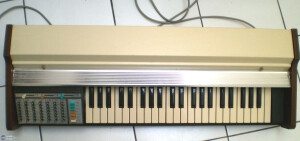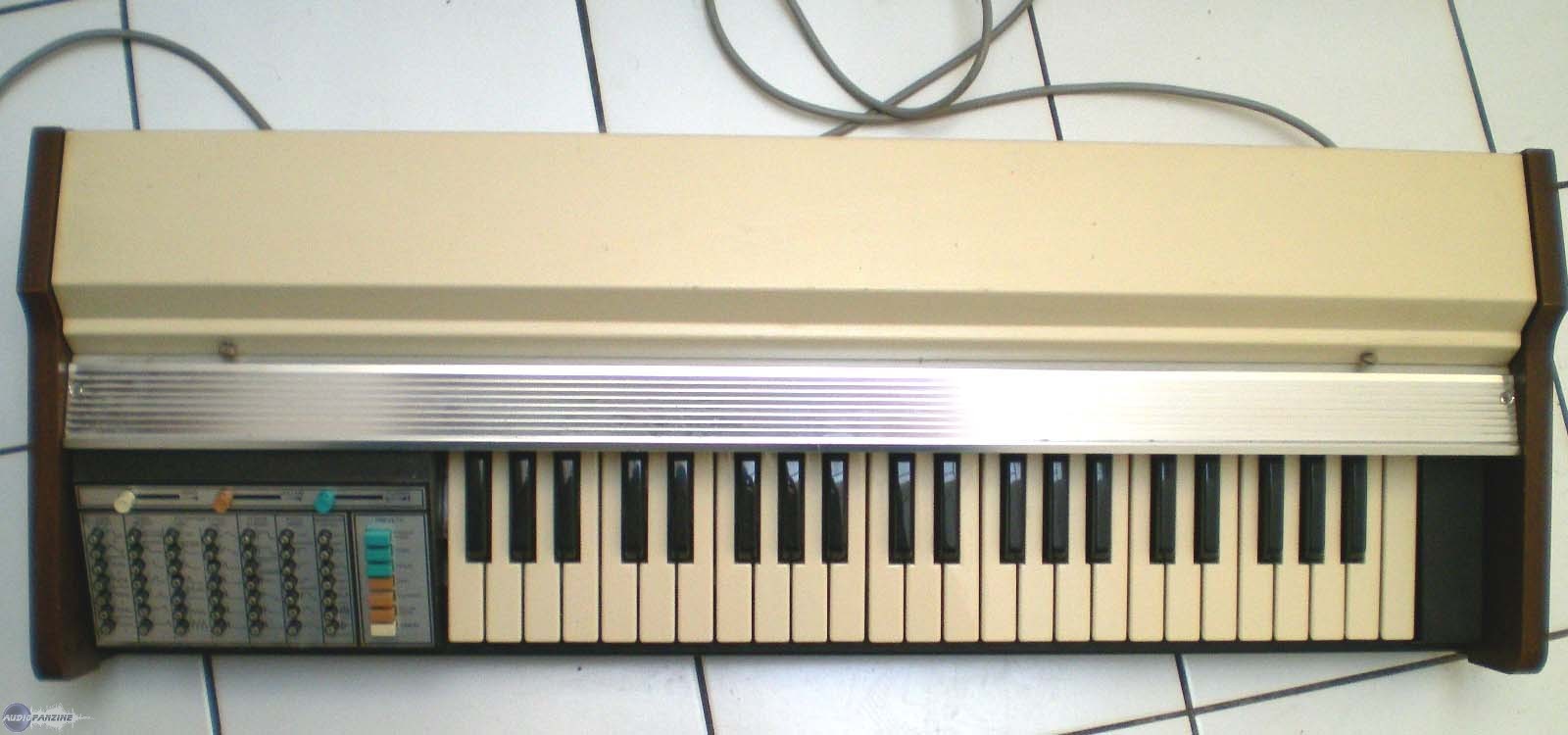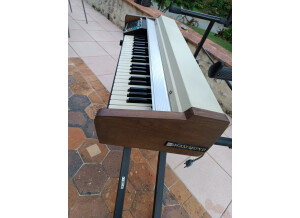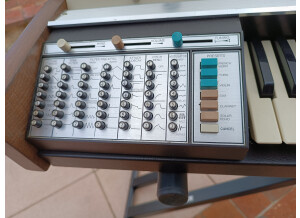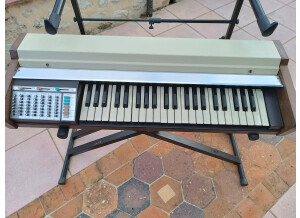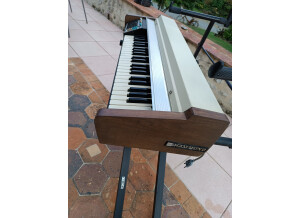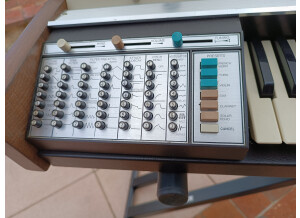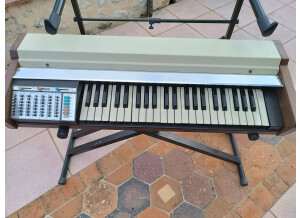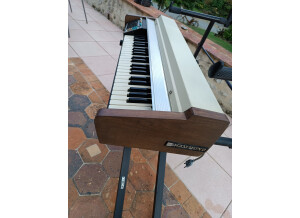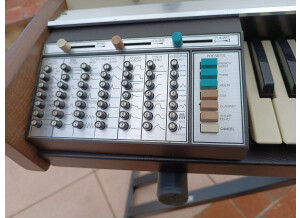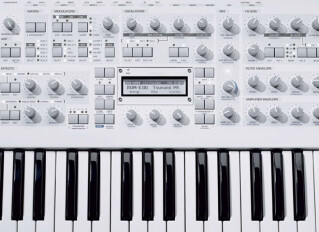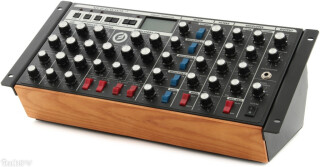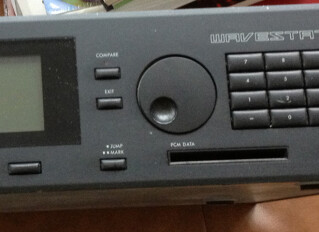102200 classified ad
Alerte nouvelle annonceImages
Videos
Reviews
4.5/5(3 reviews)
67 %
33 %
Write a user review
Published on 04/22/10 at 19:11
This is a really cool synthesizer made by Hammond, the legendary organ manufacturer. I was surprised to find that they even made synthesizers, I figured they would stick to the organs that they made their name on. However, this is a pretty cool instrument. The features are a bit limited. There are 44 keys, which isn't a whole lot, but isn't too small either. This thing is really old, so it can't be edited with any computers, and if I'm not mistaken, it predates MIDI, which makes it tough to compare to modern synths but usually means it sounds far better. It is a polyphonic and monophonic instrument. There are only 6 sounds on it, and they don't sound anything like the instruments they...…
Read more
This is a really cool synthesizer made by Hammond, the legendary organ manufacturer. I was surprised to find that they even made synthesizers, I figured they would stick to the organs that they made their name on. However, this is a pretty cool instrument. The features are a bit limited. There are 44 keys, which isn't a whole lot, but isn't too small either. This thing is really old, so it can't be edited with any computers, and if I'm not mistaken, it predates MIDI, which makes it tough to compare to modern synths but usually means it sounds far better. It is a polyphonic and monophonic instrument. There are only 6 sounds on it, and they don't sound anything like the instruments they are supposed to. There is no way to edit the sounds.
UTILIZATION
Getting a good sound out of this guy isn't too hard, but there aren't that many. The setup is easy as long as the thing is working. Considering that there's only about 50 believed to even be found on the planet, the likelihood of finding one that works and stays working is very unlikely. I have no idea whether or not there even is a manual, but it's not really necessary either. There are six presets, and also a manual mode where you have control over pitch, filter, attack/decay, pitch bend and modulation.
SOUNDS
There are no realistic sounds on this synth. I don't really understand why people expect and/or want their synths to actually sound like real instruments, considering that I have never heard one that actually does. I'm more interested in these old analog synths that have qualities al their own. The sounds that come out of this thing are pretty cool, they really aren't my favorite in the world when it comes to analog synths, but they're unique to say the least. I really don't think that there is any other instrument that sounds exactly like this, but I do think there are better ones.
OVERALL OPINION
I was expecting much more when a client of ours showed me this instrument. When he told me how rare they are, and raved about it, I felt as though playing one would have been a rare privilege that I would remember forever, it actually was pretty underwhelming. The rarity of these devices has driven the price up to an insane degree, and I would have to say that because of this, the cost would almost definitely not be worth it, especially since there aren't a whole lot of people who really know how to repair them. Since you probably won't encounter one, this is a hypothetical situation for the most part.
UTILIZATION
Getting a good sound out of this guy isn't too hard, but there aren't that many. The setup is easy as long as the thing is working. Considering that there's only about 50 believed to even be found on the planet, the likelihood of finding one that works and stays working is very unlikely. I have no idea whether or not there even is a manual, but it's not really necessary either. There are six presets, and also a manual mode where you have control over pitch, filter, attack/decay, pitch bend and modulation.
SOUNDS
There are no realistic sounds on this synth. I don't really understand why people expect and/or want their synths to actually sound like real instruments, considering that I have never heard one that actually does. I'm more interested in these old analog synths that have qualities al their own. The sounds that come out of this thing are pretty cool, they really aren't my favorite in the world when it comes to analog synths, but they're unique to say the least. I really don't think that there is any other instrument that sounds exactly like this, but I do think there are better ones.
OVERALL OPINION
I was expecting much more when a client of ours showed me this instrument. When he told me how rare they are, and raved about it, I felt as though playing one would have been a rare privilege that I would remember forever, it actually was pretty underwhelming. The rarity of these devices has driven the price up to an insane degree, and I would have to say that because of this, the cost would almost definitely not be worth it, especially since there aren't a whole lot of people who really know how to repair them. Since you probably won't encounter one, this is a hypothetical situation for the most part.
See less
11
»
Published on 12/07/08 at 10:33
(Originally written by Lux Inferno/translated from Audiofanzine FR)
It's a synthesizer, not an organ. Indeed Hammond is famous for its organs but it also made two synthesizers in the mid 70's just after being bought by the Japanese. Only two hundred 102200 were ever produced and in 2008 the number of working 102200 is estimated at only 50 in the whole world.
The keyboard has 44 keys, evidently without aftertouch or velocity. Controls? None (except for a volume and a tuning control).
There is only one output with a mono 1/4" jack.
Six basic presets (french horn, tuba, violin, sax, clarinet, solar echo) but you can also "create" sounds selecting different positions for the 49...…
It's a synthesizer, not an organ. Indeed Hammond is famous for its organs but it also made two synthesizers in the mid 70's just after being bought by the Japanese. Only two hundred 102200 were ever produced and in 2008 the number of working 102200 is estimated at only 50 in the whole world.
The keyboard has 44 keys, evidently without aftertouch or velocity. Controls? None (except for a volume and a tuning control).
There is only one output with a mono 1/4" jack.
Six basic presets (french horn, tuba, violin, sax, clarinet, solar echo) but you can also "create" sounds selecting different positions for the 49...…
Read more
(Originally written by Lux Inferno/translated from Audiofanzine FR)
It's a synthesizer, not an organ. Indeed Hammond is famous for its organs but it also made two synthesizers in the mid 70's just after being bought by the Japanese. Only two hundred 102200 were ever produced and in 2008 the number of working 102200 is estimated at only 50 in the whole world.
The keyboard has 44 keys, evidently without aftertouch or velocity. Controls? None (except for a volume and a tuning control).
There is only one output with a mono 1/4" jack.
Six basic presets (french horn, tuba, violin, sax, clarinet, solar echo) but you can also "create" sounds selecting different positions for the 49 switches on the panel and using the "wind" control that generates white noise. It's not possible to "combine" different presets. If you use the panel switches you have to deselect the presets.
An LFO and a VCO are also provided.
There is no sound memory.
The synth is monophonic which was standard at the time (the first polyphonic synth was the Polymoog).
It can only be powered with 230 V and there is no possibility to switch to 110 V so I think it was only conceived for the European market.
Inside the cabinet the electronics are extremely simple: one card = one function, every card is plugged into a slot.
UTILIZATION
The overall configuration extremely simple. Just press the buttons and that's it. It couldn't be more "plug and play". So sound editing is accessible to anyone, no user's manual is needed.
Sound editing: you have two options, either you choose from the six sound presets or you depress the "cancel" button (disabling all other preset buttons ) and enter sound editing mode. The control is divided in five main sections:
- "Tone pitch" allows you to select the pitch setting (32, 16, 8 or 4) with the possibility to select square or triangle waveform for each setting (except for the last setting [4'] which only has a sawtooth waveform)
- "Tone filter" (when the filter is active) and "Filter rise and fall" (width and speed) that control the resonant filter. Both controls have a bypass function.
- "Attack/decay" is nothing but the standard ADSR envelope .
- "Pitch bend" allows you to adjust the pitch bend time.
- "Modulator" is an enhanced vibrato effect that creates a fuzz-like effect with certain sounds.
The "Wind" control produces white noise that can be added to the sound you edited, but the noise generator can also be used on its own and be modulated by the filter and the ADSR envelope (all other settings don't have any effect on it).
SOUNDS
The sound is not realistic (I never understood why some manufacturers committed themselves to presenting synthesizers that imitated other instruments, when they were instruments in their own right and with their own particular character).
Expressiveness has no meaning with this sort of equipment.
Regarding the six sound presets only the "clarinet" sounds like a real instrument. For the other four simulated instruments (trumpet, tuba, violin and sax) the unit produces powerful (sawtooth waveform) organ sounds. The last preset (Solar) has a rather short attack with vibrato creating a fuzz effect and a resonant filter to create a sort of flanger. This preset has a disco character to it.
Bass presets are real basses (did you say VST?) and the resonant filter allows you to create acid sounds.
OVERALL OPINION
I bought it out of curiosity and this device is quite pleasant thanks to its ease of use.
The interesting thing about this collector's item is that it was conceived for the consumer market unlike the Korg MS20 and the like. It has only a few buttons, you push them and you hear the result. Each switch is labeled with a small curve indicating its function.
The device produces a good analog sound with characterful lows. In spite of its 33 years, it produces virtually no noise.
It's a synthesizer, not an organ. Indeed Hammond is famous for its organs but it also made two synthesizers in the mid 70's just after being bought by the Japanese. Only two hundred 102200 were ever produced and in 2008 the number of working 102200 is estimated at only 50 in the whole world.
The keyboard has 44 keys, evidently without aftertouch or velocity. Controls? None (except for a volume and a tuning control).
There is only one output with a mono 1/4" jack.
Six basic presets (french horn, tuba, violin, sax, clarinet, solar echo) but you can also "create" sounds selecting different positions for the 49 switches on the panel and using the "wind" control that generates white noise. It's not possible to "combine" different presets. If you use the panel switches you have to deselect the presets.
An LFO and a VCO are also provided.
There is no sound memory.
The synth is monophonic which was standard at the time (the first polyphonic synth was the Polymoog).
It can only be powered with 230 V and there is no possibility to switch to 110 V so I think it was only conceived for the European market.
Inside the cabinet the electronics are extremely simple: one card = one function, every card is plugged into a slot.
UTILIZATION
The overall configuration extremely simple. Just press the buttons and that's it. It couldn't be more "plug and play". So sound editing is accessible to anyone, no user's manual is needed.
Sound editing: you have two options, either you choose from the six sound presets or you depress the "cancel" button (disabling all other preset buttons ) and enter sound editing mode. The control is divided in five main sections:
- "Tone pitch" allows you to select the pitch setting (32, 16, 8 or 4) with the possibility to select square or triangle waveform for each setting (except for the last setting [4'] which only has a sawtooth waveform)
- "Tone filter" (when the filter is active) and "Filter rise and fall" (width and speed) that control the resonant filter. Both controls have a bypass function.
- "Attack/decay" is nothing but the standard ADSR envelope .
- "Pitch bend" allows you to adjust the pitch bend time.
- "Modulator" is an enhanced vibrato effect that creates a fuzz-like effect with certain sounds.
The "Wind" control produces white noise that can be added to the sound you edited, but the noise generator can also be used on its own and be modulated by the filter and the ADSR envelope (all other settings don't have any effect on it).
SOUNDS
The sound is not realistic (I never understood why some manufacturers committed themselves to presenting synthesizers that imitated other instruments, when they were instruments in their own right and with their own particular character).
Expressiveness has no meaning with this sort of equipment.
Regarding the six sound presets only the "clarinet" sounds like a real instrument. For the other four simulated instruments (trumpet, tuba, violin and sax) the unit produces powerful (sawtooth waveform) organ sounds. The last preset (Solar) has a rather short attack with vibrato creating a fuzz effect and a resonant filter to create a sort of flanger. This preset has a disco character to it.
Bass presets are real basses (did you say VST?) and the resonant filter allows you to create acid sounds.
OVERALL OPINION
I bought it out of curiosity and this device is quite pleasant thanks to its ease of use.
The interesting thing about this collector's item is that it was conceived for the consumer market unlike the Korg MS20 and the like. It has only a few buttons, you push them and you hear the result. Each switch is labeled with a small curve indicating its function.
The device produces a good analog sound with characterful lows. In spite of its 33 years, it produces virtually no noise.
See less
00
»
Published on 11/09/08 at 06:30
(Originally written by Lux Inferno/translated from Audiofanzine FR)
It's a synthesizer, not an organ. Indeed Hammond is famous for its organs but it also made two synthesizers in the mid 70's just after being bought by the Japanese. Only two hundred 102200 were ever produced and in 2008 the number of working 102200 is estimated at only 50 in the whole world.
The keyboard has 44 keys, evidently without aftertouch or velocity. Controls? None (with exception of a control and a tuning control).
There is only one output with a mono 1/4" jack.
6 basic presets (french horn, tuba, violin, sax, clarinet, solar echo) but you can also "create" sounds selecting different positions for the 49...…
It's a synthesizer, not an organ. Indeed Hammond is famous for its organs but it also made two synthesizers in the mid 70's just after being bought by the Japanese. Only two hundred 102200 were ever produced and in 2008 the number of working 102200 is estimated at only 50 in the whole world.
The keyboard has 44 keys, evidently without aftertouch or velocity. Controls? None (with exception of a control and a tuning control).
There is only one output with a mono 1/4" jack.
6 basic presets (french horn, tuba, violin, sax, clarinet, solar echo) but you can also "create" sounds selecting different positions for the 49...…
Read more
(Originally written by Lux Inferno/translated from Audiofanzine FR)
It's a synthesizer, not an organ. Indeed Hammond is famous for its organs but it also made two synthesizers in the mid 70's just after being bought by the Japanese. Only two hundred 102200 were ever produced and in 2008 the number of working 102200 is estimated at only 50 in the whole world.
The keyboard has 44 keys, evidently without aftertouch or velocity. Controls? None (with exception of a control and a tuning control).
There is only one output with a mono 1/4" jack.
6 basic presets (french horn, tuba, violin, sax, clarinet, solar echo) but you can also "create" sounds selecting different positions for the 49 switches on the panel and using the "wind" control that generates white noise. It's not possible to "combine" different presets. If you use the panel switches you have to deselect the presets.
A LFO and a VCO are also provided.
There is no sound memory.
The synth is monophonic which was standard at the time (the first polyphonic synth was the Polymoog).
It can only be powered with 230 V and there is no possibility to switch to 110 V so I think it was only conceived for the European market.
Inside the cabinet the electronics are extremely simple: one card = one function, every card is plugged into a slot.
UTILIZATION
The overall configuration is extremely simple. Just push the buttons and that's it. It couldn't be more "plug and play". So sound editing is open to anyone, no user's manual needed.
SOUNDS
The sound is not realistic (I never understood why some manufacturers committed themselves to presenting synthesizers that imitated other instruments, when they were actually instruments in their own right and with their own particular character).
Expressiveness has no meaning with this sort of equipment.
OVERALL OPINION
The interesting point of this collector's item is that it was designed for the consumer market unlike the Korg MS20 and many others. It has only a few buttons, you push them and you hear the result. And each switch is labeled with a small curve indicating its function.
As soon as I spend more time with the unit, I'll post information regarding the sound. I found it recently and bought it out of curiosity.
It's a synthesizer, not an organ. Indeed Hammond is famous for its organs but it also made two synthesizers in the mid 70's just after being bought by the Japanese. Only two hundred 102200 were ever produced and in 2008 the number of working 102200 is estimated at only 50 in the whole world.
The keyboard has 44 keys, evidently without aftertouch or velocity. Controls? None (with exception of a control and a tuning control).
There is only one output with a mono 1/4" jack.
6 basic presets (french horn, tuba, violin, sax, clarinet, solar echo) but you can also "create" sounds selecting different positions for the 49 switches on the panel and using the "wind" control that generates white noise. It's not possible to "combine" different presets. If you use the panel switches you have to deselect the presets.
A LFO and a VCO are also provided.
There is no sound memory.
The synth is monophonic which was standard at the time (the first polyphonic synth was the Polymoog).
It can only be powered with 230 V and there is no possibility to switch to 110 V so I think it was only conceived for the European market.
Inside the cabinet the electronics are extremely simple: one card = one function, every card is plugged into a slot.
UTILIZATION
The overall configuration is extremely simple. Just push the buttons and that's it. It couldn't be more "plug and play". So sound editing is open to anyone, no user's manual needed.
SOUNDS
The sound is not realistic (I never understood why some manufacturers committed themselves to presenting synthesizers that imitated other instruments, when they were actually instruments in their own right and with their own particular character).
Expressiveness has no meaning with this sort of equipment.
OVERALL OPINION
The interesting point of this collector's item is that it was designed for the consumer market unlike the Korg MS20 and many others. It has only a few buttons, you push them and you hear the result. And each switch is labeled with a small curve indicating its function.
As soon as I spend more time with the unit, I'll post information regarding the sound. I found it recently and bought it out of curiosity.
See less
00
»
Tech. sheet
- Manufacturer: Hammond
- Model: 102200
- Category: Analog Synths
- Added in our database on: 11/09/2008
We have no technical specifications for this product
but your help will be much welcomed
»
Other categories in Synthesizers/Racks/Modules
Other names: 10 2200


